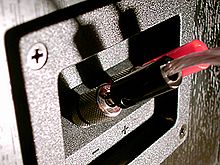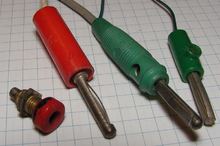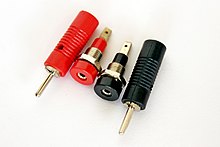Banana plugs

A banana plug , also known as a 4 mm spring plug or lamellar plug , is a plug connector designed primarily for electrical laboratories for low voltage with low to medium electrical current (usually up to 16 A). It owes its name to the banana shape of the leaf spring element with which the plug sits relatively firmly in the socket, but can still be detached without tools. The banana socket (also called the telephone socket) must have a diameter of 4 mm. The diameter of the connector can be varied by several tenths of a millimeter thanks to the spring element.
use
The plug, which is still in use today, was developed by Hirschmann GmbH in 1924 in order to replace the spring clips and screw connections that had been used in experimental setups up to that point . Although similar plug connections already existed before (with different diameters and lengths), the product offered such advantages through its overall construction (contact, suspension and insulation, at that time still made of Bakelite ) that it established itself as the " quasi-standard " of laboratory technology.
Previously, many connections were made with screw terminals in laboratory technology, which required very careful processing. As a counterpart to the banana plug, however, a simple 4 mm hole in a metal block is sufficient.
Banana plugs are perfectly suitable for signal transmission due to the reliable multi-point connection between plug and socket, but the usual laboratory cables with banana plugs have no shielding against interference.
hazards
Banana plugs fit into mains sockets if they are not equipped with a child safety device. To avoid electrical accidents, there are special Schuko plugs with insulated safety sockets for drawing mains power using banana plugs .
Executions
4 mm connector system
There are many versions of banana plugs. The coupling or the transverse hole in the connector, which is almost always present, is important for laboratory setups, which means that additional connectors can be quickly connected to a certain point in the test setup.
The so-called tufted plugs are a popular variant. Instead of the leaf spring, which is bent in the shape of a banana, there is a number (usually six) of resilient wires. Usually they are held together with a central spike and a cap at the top. Tuft plugs are cheaper to manufacture and easier to plug in, but have higher contact resistance. Plugs that have a ring-shaped spring element are also widespread. These are also available in a gold-plated version.
A shock protection to ensure there are two methods: First, there are banana plugs which have an advanced with spring plastic socket to the plug and a plastic cap. They fit into conventional sockets and couplings. They are safe to touch to a limited extent and can therefore also be used for mains voltage. In addition, there are also versions with a rigid insulating sleeve and therefore finger-safe, which, however, only fit into matching sockets and couplings that can accommodate the insulating sleeve. This guarantees protection against accidental contact with multimeters.
Banana sockets are also often used as loudspeaker plugs on amplifiers and loudspeaker boxes. Usually they are slightly larger and the insulation body is designed as a screw so that the speaker wire to optimize the contact resistance can be clamped directly. This design can also be found on some measuring devices and laboratory power supplies.
Many versions can be plugged together.
Other diameters
For laboratory setups with low voltages and a large number of sockets, there is also a plug system with a 2 mm socket diameter. Plugs with a ring-shaped spring element are almost always used here.
Various plug-in systems with 2.4 mm to 2.6 mm socket diameters are common in model railway construction. Because of the lower manufacturing costs, plugs with a slotted contact are mostly used here, which only have the transverse hole in common with the classic banana plugs.
For higher currents, there are single-pole connector systems with a nominal diameter of 6 mm. They can withstand continuous currents of around 80 amps and are also available in a lockable version.
See also
- Connectors
- Connection technology (electrical engineering)
- Crocodile clip (gripping clamp with 4-mm-sleeve for banana plugs)




